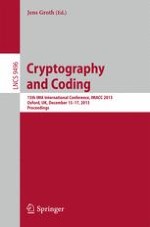2015 | OriginalPaper | Buchkapitel
Shannon Entropy Versus Renyi Entropy from a Cryptographic Viewpoint
verfasst von : Maciej Skórski
Erschienen in: Cryptography and Coding
Aktivieren Sie unsere intelligente Suche, um passende Fachinhalte oder Patente zu finden.
Wählen Sie Textabschnitte aus um mit Künstlicher Intelligenz passenden Patente zu finden. powered by
Markieren Sie Textabschnitte, um KI-gestützt weitere passende Inhalte zu finden. powered by
